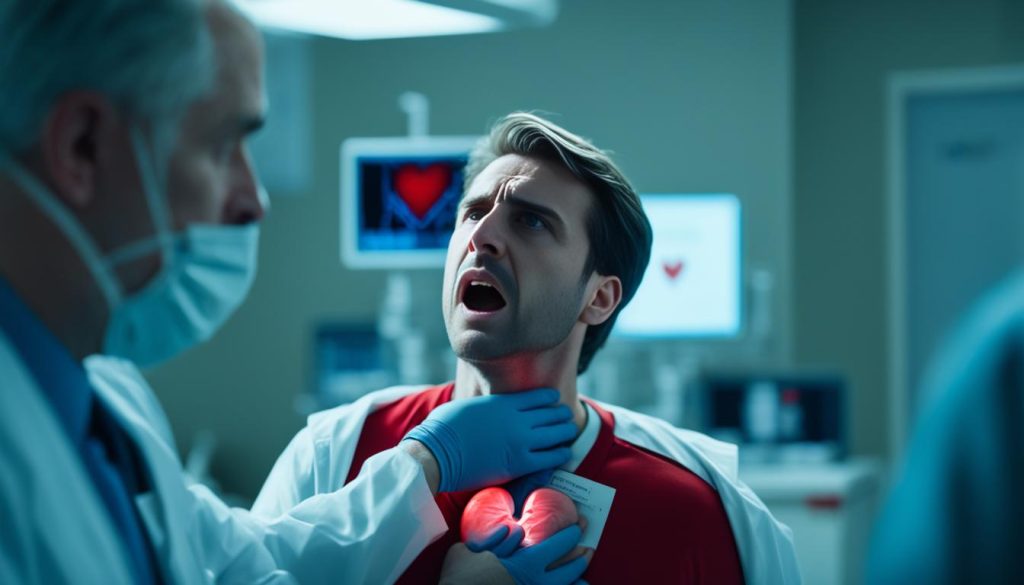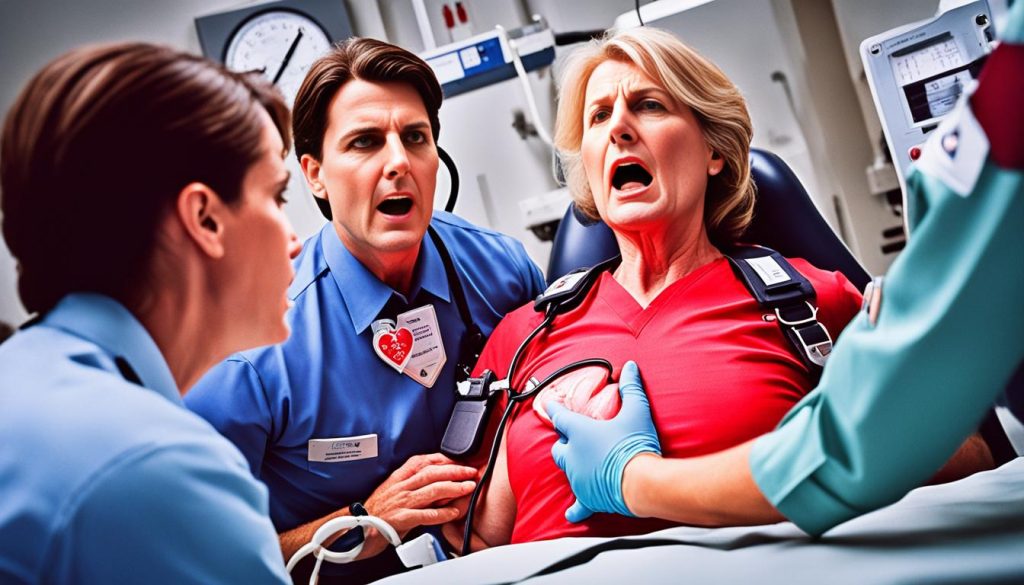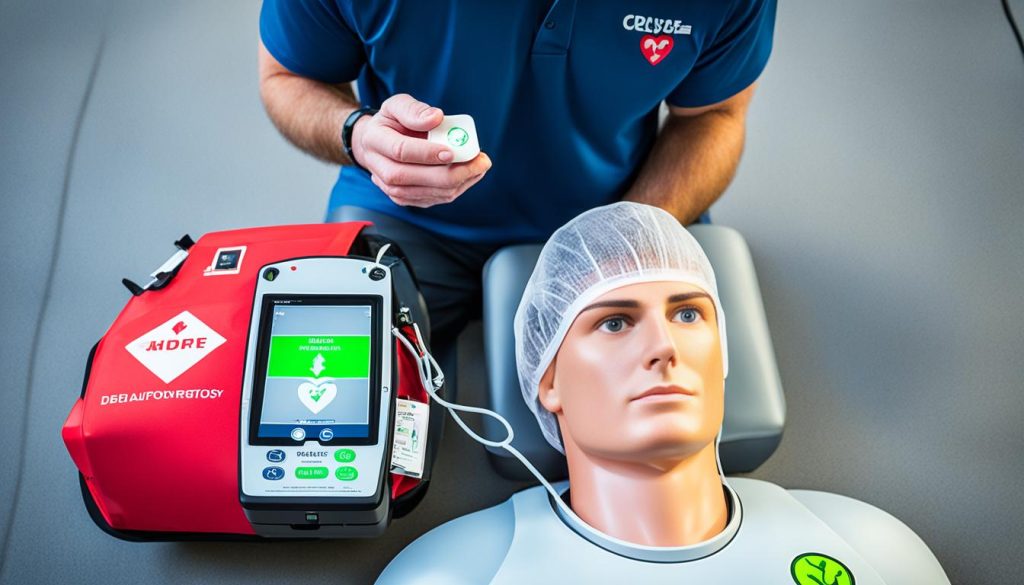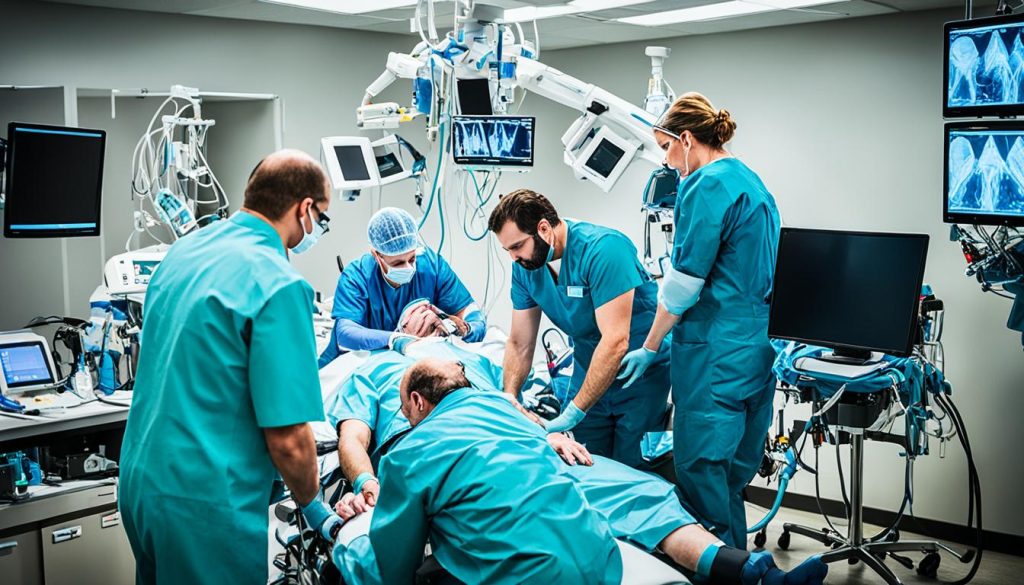A heart attack is a life-threatening medical emergency that requires immediate attention. Understanding the timeline of a heart attack and its fatality is crucial for prompt action and increasing the chances of survival.
Sudden cardiac death (SCD) typically occurs within one hour of the onset of symptoms. The most common cause of SCD is coronary artery disease, which accounts for up to 80% of cases. Other causes include cardiomyopathies and genetic channelopathies.
In patients younger than 35, fatal arrhythmias are more common, while congenital abnormalities are the primary cause in younger patients. Sudden cardiac death is most likely to happen between 6 am and noon, with a smaller peak in the late afternoon. The overall survival rate for sudden cardiac arrest is around 7%.
How Long Does a Heart Attack Take to Kill You?
Causes of Sudden Cardiac Death
Sudden cardiac death (SCD) is a life-threatening event that occurs suddenly and unexpectedly. It is often caused by underlying heart conditions, including ischemic heart disease, cardiomyopathies, and genetic channelopathies.
The most common cause of sudden cardiac death is coronary artery disease, which accounts for up to 80% of cases. This condition occurs when the blood vessels that supply the heart muscle become narrow or blocked, reducing blood flow and increasing the risk of a heart attack.
Individuals with ischemic heart disease are at a higher risk of experiencing sudden cardiac death due to the potential development of fatal arrhythmias.
Cardiomyopathies can also lead to sudden cardiac death. These conditions involve the enlargement, thickening, or stiffening of the heart muscle, which can disrupt the heart’s electrical system and cause irregular heart rhythms.
In addition, certain genetic channelopathies can result in abnormalities in the ion channels that control the heart’s electrical signals, leading to life-threatening arrhythmias and sudden cardiac death.
The specific causes of sudden cardiac death can vary depending on the age group. In patients younger than 35, fatal arrhythmias are more common, while congenital abnormalities are the primary cause in younger patients. Other conditions such as myocarditis, heart failure, valve disease, and congenital diseases can also increase the risk of sudden cardiac death.
To better understand the causes of sudden cardiac death, refer to the table below:
| Cause | Description |
|---|---|
| Ischemic Heart Disease | A narrowing or blockage of the blood vessels that supply the heart, reducing blood flow and increasing the risk of fatal arrhythmias. |
| Cardiomyopathies | Enlargement, thickening, or stiffness of the heart muscle, disrupting the heart’s electrical system and leading to irregular heart rhythms. |
| Genetic Channelopathies | Abnormalities in the ion channels that control the heart’s electrical signals, causing life-threatening arrhythmias. |
| Myocarditis | Inflammation of the heart muscle, often caused by viral infections or autoimmune diseases. |
| Heart Failure | A condition in which the heart is unable to pump blood effectively, leading to an increased risk of arrhythmias. |
| Valve Disease | Abnormalities in the heart valves that affect blood flow, potentially leading to arrhythmias and sudden cardiac death. |
| Congenital Diseases | Structural abnormalities present at birth that affect the heart’s function and electrical system, increasing the risk of sudden cardiac death. |
It is important to note that sudden cardiac death can occur without any prior symptoms or warning signs. Understanding the causes and risk factors associated with sudden cardiac death can help identify individuals at higher risk and implement preventive measures.
Symptoms and Diagnosis of a Heart Attack
A heart attack can present with various symptoms, which include:
- Chest pain or discomfort: This is the most common symptom of a heart attack. The pain can feel like pressure, tightness, squeezing, or fullness in the chest.
- Shortness of breath: You may experience difficulty breathing or feel like you can’t catch your breath.
- Nausea: Some people may feel sick to their stomach or vomit during a heart attack.
- Lightheadedness: Feeling dizzy or lightheaded can be a symptom of a heart attack.
- Pain in the arm, back, jaw, or neck: The pain can radiate to these areas, often on the left side of the body.
If you suspect a heart attack, it’s crucial to seek emergency medical attention immediately. Delaying medical care can result in worsening of the condition and increase the risk of complications.
Diagnosing a heart attack commonly involves:
- Medical history: Your doctor will inquire about your symptoms, medical history, and any risk factors for heart disease.
- Physical examination: A thorough examination may be conducted to evaluate your overall health and check for signs of a heart attack.
- Electrocardiogram (ECG): This non-invasive test measures the electrical activity of the heart. It helps identify abnormal heart rhythms and patterns that may indicate a heart attack.
- Echocardiogram: An echocardiogram uses sound waves to create detailed images of the heart’s structure and function. It can provide valuable information about the heart’s pumping ability and identify areas of damage.

The combination of medical history, physical examination, and diagnostic tests such as an ECG and echocardiogram helps healthcare professionals accurately diagnose a heart attack. Timely diagnosis is essential for prompt treatment and improving outcomes.
| Diagnostic Tests for Heart Attack | Purpose |
|---|---|
| Medical history | Assess symptoms and risk factors |
| Physical examination | Evaluate overall health |
| Electrocardiogram (ECG) | Measure heart’s electrical activity |
| Echocardiogram | Assess heart’s structure and function |
What Happens During Cardiac Arrest?
Cardiac arrest occurs when an electrical malfunction in the heart causes an irregular heartbeat, leading to the heart’s inability to pump blood effectively. This results in a loss of consciousness and absence of a pulse. Without prompt medical intervention, death can occur within minutes. Cardiac arrest is different from a heart attack, which is a blockage in the arteries that supply blood to the heart.
During cardiac arrest, the heart’s electrical system malfunctions, causing the heart to beat abnormally or stop beating altogether. This irregular heartbeat, known as arrhythmia, prevents the heart from effectively pumping oxygenated blood to the body’s vital organs and tissues. Without this oxygenated blood supply, the brain and other organs quickly suffer damage and fail to function properly.
When cardiac arrest occurs, the person experiencing it will lose consciousness and collapse. They will not have a pulse, and their breathing will either be absent or irregular. Immediate medical attention and intervention are crucial to restoring normal heart rhythm and saving their life.
Signs and Symptoms of Cardiac Arrest:
- No pulse
- Loss of consciousness
- Shortness of Breathing
- Unresponsiveness
Cardiac arrest can occur suddenly and without warning, making it a life-threatening emergency that requires immediate action. Recognizing the signs and symptoms of cardiac arrest and taking prompt measures, such as calling 911 and performing cardiopulmonary resuscitation (CPR), can significantly increase the chances of survival.
It’s important to note that cardiac arrest can affect individuals of all ages, including those without prior heart conditions. However, certain factors, such as a history of heart disease, high blood pressure, smoking, obesity, and a sedentary lifestyle, can increase the risk of experiencing cardiac arrest.

Knowing what to do in the event of cardiac arrest can make all the difference in saving a life. Immediate action, including CPR and defibrillation with an automated external defibrillator (AED), can significantly improve the chances of restoring normal heart rhythm and increasing survival rates.
Actions to Take During a Heart Attack or Cardiac Arrest
If you suspect a heart attack, it’s crucial to take immediate action to increase the chances of survival. The following steps should be taken:
- Call 911: Dial emergency services right away. The quicker medical professionals arrive, the better the chances of a positive outcome. Remember, every minute counts during a heart attack.
- Seek emergency medical attention: While waiting for medical help to arrive, it’s important to stay calm and try to keep the affected person calm as well. Encourage them to sit or lie down comfortably, as sudden movements may worsen the situation.
- Chew aspirin: If aspirin is available, ask the person experiencing the heart attack to chew and swallow one. Aspirin can help prevent blood clots from forming and minimize damage to the heart.
When it comes to cardiac arrest, immediate action is vital for survival. The following actions should be taken:
- Check for responsiveness: Ensure the person is unresponsive by gently shaking them and calling their name.
- Call 911: Dial emergency services immediately and relay the situation. Clearly communicate that the person is experiencing cardiac arrest.
- Use an Automated External Defibrillator (AED): If an AED is nearby, follow the provided instructions to deliver a shock if necessary. AEDs are designed to restore the heart’s normal rhythm.
- Start CPR: If you are trained in CPR, perform high-quality chest compressions until professional medical help arrives. CPR helps maintain blood flow to the vital organs, increasing the chances of survival.
It’s essential to remember that these actions are applicable to adults. For children and infants, a similar approach should be taken, while also considering that airway obstruction is a common cause of cardiac arrest in this age group.
CPR Technique Reminder
If you encounter someone in cardiac arrest and are unsure of the proper CPR technique, follow these steps:
- Kneel beside the person and locate the center of their chest.
- Place the heel of one hand on the center of the chest.
- Place your other hand on top of the first hand, interlocking your fingers.
- Position yourself with straight arms, shoulders directly above your hands.
- Use your body weight to compress the chest at least 2 inches deep. Allow the chest to fully recoil between compressions.
- Perform compressions at a rate of 100-120 compressions per minute.
- Continue CPR until professional medical help takes over.
Remember, quick action during a heart attack or cardiac arrest can make a life-saving difference. Prioritize calling emergency services, delivering CPR, and using an AED if available to increase the chances of survival.

| Cardiac Event | Recommended Actions |
|---|---|
| Heart attack |
|
| Cardiac arrest |
|
By following these actions, you can play a critical role in potentially saving a life during a heart attack or cardiac arrest.
Treatment and Prognosis for Heart Attacks and Cardiac Arrest
Timely treatment plays a critical role in the management of heart attacks and cardiac arrest. The treatment options for these life-threatening conditions vary based on the specific circumstances and underlying causes. The goal of treatment is to restore blood flow to the heart or maintain normal heart rhythm to improve the chances of survival.
Treatment for Heart Attacks
The immediate treatment for a heart attack typically involves administering medications to dissolve the blood clot causing the blockage or improve blood flow through the coronary arteries. Common medications used include aspirin, nitroglycerin, and thrombolytics. In more severe cases, procedures like percutaneous coronary intervention (PCI) or coronary artery bypass grafting (CABG) may be recommended to restore blood flow to the heart.
After the initial intervention, long-term treatment plans aim to address the underlying cause of the heart attack and minimize the risk of future episodes. Lifestyle changes such as adopting a heart-healthy diet, engaging in regular physical activity, and quitting smoking are often recommended. Medications may also be prescribed to manage risk factors such as high blood pressure, cholesterol, and diabetes. In certain cases, surgical interventions may be necessary to correct structural abnormalities or restore proper heart function.
Treatment for Cardiac Arrest
In cases of cardiac arrest, immediate action is crucial for survival. Cardiopulmonary resuscitation (CPR) should be initiated promptly to maintain blood circulation and provide oxygen to vital organs. CPR is typically followed by defibrillation, which involves delivering an electric shock to restore a normal heart rhythm.
Therapeutic hypothermia, a specialized treatment technique, may be utilized in some cases to limit neurological damage following cardiac arrest. It involves cooling the body to a lower temperature to reduce the risk of brain injury and improve overall outcomes.
Long-term treatment for cardiac arrest focuses on addressing the underlying cause and preventing future episodes. Similar to heart attack management, lifestyle modifications, medications, and surgical interventions may be recommended to manage cardiovascular risk factors and optimize heart health.
Survival Rate
The survival rate for cardiac arrest remains relatively low at around 7%. However, prompt recognition, early initiation of CPR, and access to defibrillation significantly increase the chances of survival. The effectiveness of treatment depends on various factors, including the underlying cause, timely medical intervention, and overall health of the individual.

Conclusion
Preventing heart attacks and cardiac arrest is crucial for maintaining heart health. Early recognition of symptoms and taking prompt action is key to improving chances of survival. If you suspect a heart attack or witness someone experiencing cardiac arrest, call emergency medical services (EMS) immediately. Remember, every minute counts in these life-threatening situations.
Cardiopulmonary resuscitation (CPR) plays a vital role in providing immediate aid. Knowing how to perform CPR and starting it without delay can significantly increase the chances of saving a life. Education and training in CPR are essential for individuals to be prepared for emergencies.
In addition to emergency response, prevention is equally important. Being aware of risk factors for heart disease and taking proactive measures can help reduce the likelihood of heart attacks and cardiac arrest. Regular exercise, maintaining a healthy diet, and scheduling regular check-ups with healthcare professionals are crucial steps in maintaining heart health.
By prioritizing early recognition, emergency medical services, and cardiopulmonary resuscitation, we can work together to prevent heart-related emergencies and make a positive impact on overall heart health.




